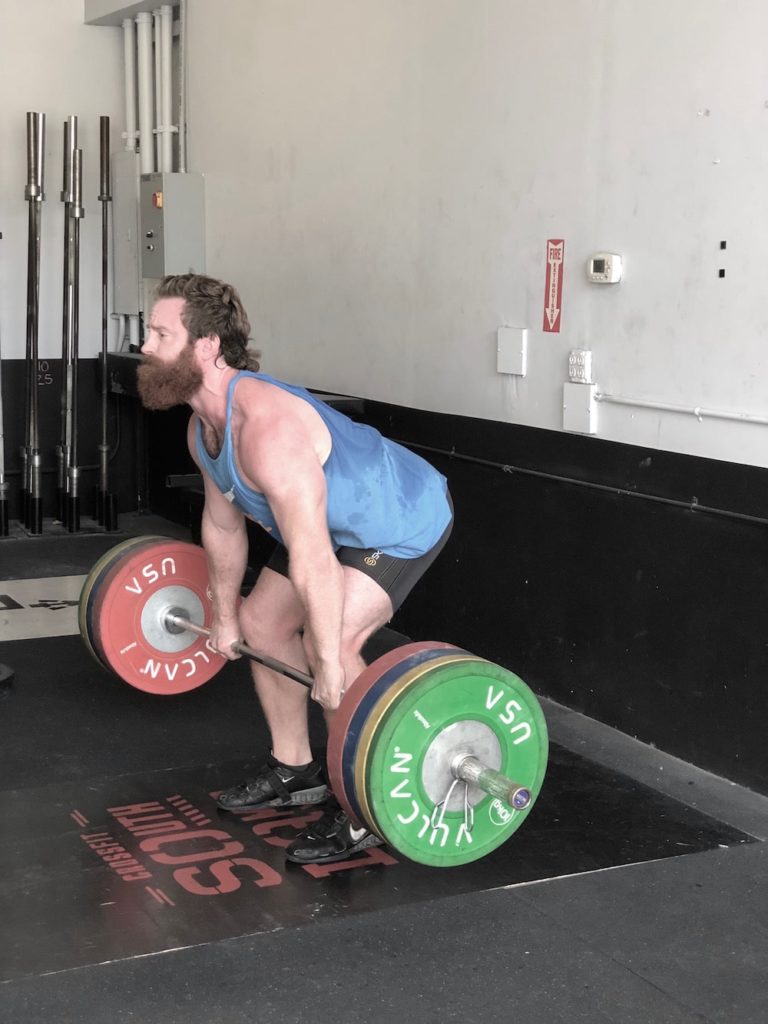The hang position has many benefits for improving efficiency in the snatch and clean & jerk, such as more time under tension, increased back strength, and better awareness throughout the lifts. There are many variations of the hang, which include the power position, high hang, top of the knee, below the knee, and just above the floor.
This article is going to focus on below and above the knee variations, and why it is my opinion that below the knee is more beneficial. Let’s dive deeper into my observations and experiences between the two and why below the knee will give you better results!
My Coach
My current coach, Oleg Kechko, a 1996 Olympian from Belarus, has influenced me the most in this particular matter. The first time I asked him why we never train hang above the knee, he responded, “Don’t lie to yourself.” After training with him and coaching others for many years, I figured out what he meant. For example, there was a time in my career where I could POWER snatch from the high hang (mid thigh) almost as much as my best SQUAT snatch from the floor.
I also recognized other athletes I coached doing more weights from above the knee, and anything below the knee was very inconsistent with low correlation to their lifts from the floor. After asking my coach why that was, he explained that when you go below the knee it is a harder position and more realistic to the classic lift. He further explained that lifts from the hang above the knee leads to inconsistent technique, which we will get into later. With this new information, I was much more observant about these details and they held up to be true for myself and my clients.
Above The Knee
I started noticing that performing lifts from above the knee led to inconsistent contact, leaning back, jumping forward, and poor bar path. This is because the timing and angle are much different between the two positions. For example, in order to have proper timing and contact from above the knee, you must on purpose drift the bar away or drag it up the thigh, which both would be considered incorrect technique from the floor. This teaches bad habits especially for beginners or less experienced lifters who are trying to develop a feel for the lifts.
One argument for going above the knee would be to increase the speed and efficiency of the catch. In this case, I like to utilize “tall” snatch/clean or perform the lifts from the “power position.” I also like to utilize blocks from above the knee. With blocks you can set up properly before lifting the weight, and don’t have to try and create angles like I mentioned above. These variations will teach speed under the bar and a tight bar path without straying away from proper technique. In summary, if you are going above the knee, there are other options besides the hang that can give you a similar stimulus. Anything else usually leads to improper technique and confusion.
Now let’s look at why below the knee is best!
Below The Knee
https://www.instagram.com/p/BapUhvXA2ZC
First of all, going from below the knee is much harder due to more time under tension, and having to navigate around the knee. If you’re going to lift from the hang, let’s get the most bang for our buck and train a tougher position, which will in reality help your lifts from the floor. Learning how to properly pass the knee while staying “over the bar” is critical! This is where a lot of people are weak and/or confused. The angle below the knee will give you direct feedback if you are too forward or leaning back too much.
If you are working from above the knee, you won’t learn these critical angles or develop the strength to stay “over the bar.”
Another benefit of training from below the knee is that it allows you more space, which makes it easier to make proper contact. It is much harder to create proper contact from above the knee due to the shorter distance. This is where you will see people leaning back or letting the bar drift too far forward in an attempt to make contact. Remember that we utilize assistance lifts to improve our snatch and clean & jerk, not become champions from the hang!
https://www.instagram.com/p/Ba1__G7As_m
These are my observations from my own training and the many people I’ve trained over the years. I coach people for a living, so I get to see and experiment with these things every day. I always recommend to do what works for you, but remember, “Don’t lie to yourself!” If you are lifting big weights above the knee, ask yourself, does this match up with my current lifts from the floor?
If there is a huge discrepancy, I recommend more lifts from below the knee. Keep an eye out, and if you see someone doing snatch or clean from the high hang, check to see if they are making the same mistakes mentioned above. If you are a coach and you are having trouble teaching someone to make contact or stay over the bar, hang below the knee will always help. In conclusion, if you are going to work lifts from the hang, below the knee is best for improving your strength, timing, and efficiency of the classic lifts.
Featured image: Andy Blaida
Editor’s note: This article is an op-ed. The views expressed herein and in the video are the authors and don’t necessarily reflect the views of BarBend. Claims, assertions, opinions, and quotes have been sourced exclusively by the author.
